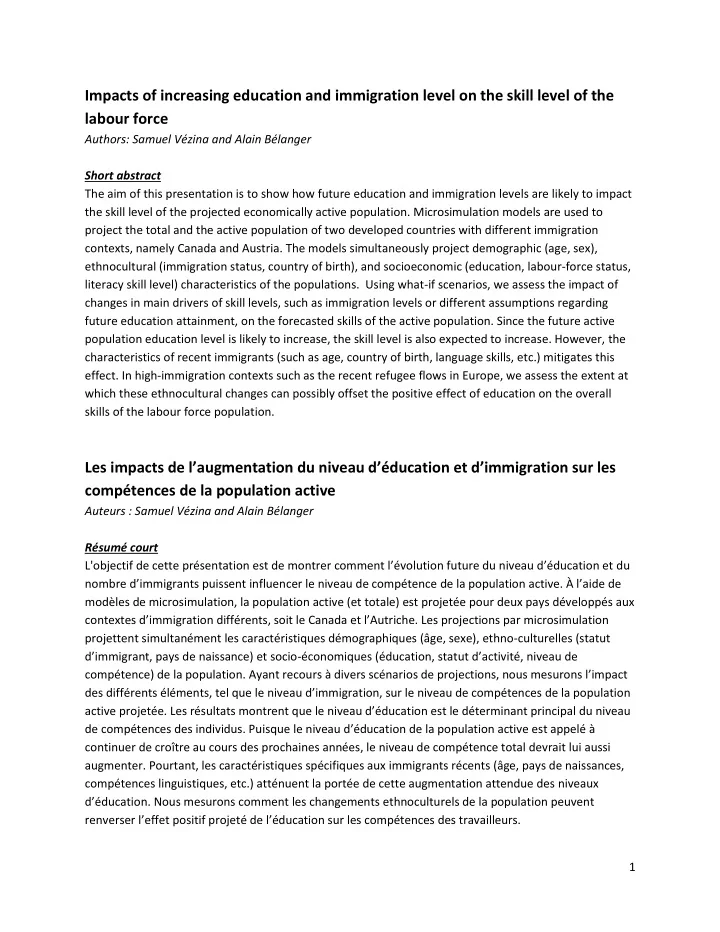

Impacts of increasing education and immigration level on the skill level of the labour force Authors: Samuel Vézina and Alain Bélanger Short abstract The aim of this presentation is to show how future education and immigration levels are likely to impact the skill level of the projected economically active population. Microsimulation models are used to project the total and the active population of two developed countries with different immigration contexts, namely Canada and Austria. The models simultaneously project demographic (age, sex), ethnocultural (immigration status, country of birth), and socioeconomic (education, labour-force status, literacy skill level) characteristics of the populations. Using what-if scenarios, we assess the impact of changes in main drivers of skill levels, such as immigration levels or different assumptions regarding future education attainment, on the forecasted skills of the active population. Since the future active population education level is likely to increase, the skill level is also expected to increase. However, the characteristics of recent immigrants (such as age, country of birth, language skills, etc.) mitigates this effect. In high-immigration contexts such as the recent refugee flows in Europe, we assess the extent at which these ethnocultural changes can possibly offset the positive effect of education on the overall skills of the labour force population. Les impacts de l’augmentation d u niveau d’éducation et d’immigration sur les compétences de la population active Auteurs : Samuel Vézina and Alain Bélanger Résumé court L'objectif de cette pré sentation est de montrer comment l’évolution future du niveau d’éducation et du nombre d’immigrants puissent influencer le niveau de compétence de la population active. À l’aide de modèles de microsimulation, la population active (et totale) est projetée pour deux pays développés aux contextes d’immigration différents, soit le Canada et l’Autriche. Les projections par microsimulation projettent simultanément les caractéristiques démographiques (âge, sexe), ethno-culturelles (statut d’immigrant, pays de nais sance) et socio- économiques (éducation, statut d’activité, niveau de compétence) de la population. Ayant recours à divers scénarios de projections, nous mesurons l’impact des différents éléments, tel que le niveau d’immigration, sur le niveau de compétence s de la population active projetée. Les résultats montrent que le niveau d’éducation est le déterminant principal du niveau de compétences des individus. Puisque le niveau d’éducation de la population active est appelé à continuer de croître au cours des prochaines années, le niveau de compétence total devrait lui aussi augmenter. Pourtant, les caractéristiques spécifiques aux immigrants récents (âge, pays de naissances, compétences linguistiques, etc.) atténuent la portée de cette augmentation attendue des niveaux d’éducation. Nous mesurons comment les changements ethnoculturels de la population peuvent renverser l’effet positif projeté de l’éducation sur les compétences des travailleurs. 1
Impacts of increasing education and immigration level on the skill level of the labour force Authors: Samuel Vézina and Alain Bélanger Introduction In most developed countries, current immigration has reached historical levels; population growth is now mainly fueled by immigration (Wilson, Sobotka, Williamson, & Boyle, 2013). In the context of population ageing where a growing number of people is about to withdraw from the labour market, pressures to keep immigration rates at high levels are likely to persist. However, developed countries have different approaches to migration. On one hand, there are countries with a long history of immigration such as Canada, the United States, Australia, and New Zealand. Despite important variations over time, they have admitted record numbers of immigrants for centuries. Still today, the United States is the OECD’s leading destination country receiving about 20% of the world’s immigrant inflow; Australia, New Zealand and Canada countries have one of the highest proportions of foreign-born as of total population (OECD, 2017a). Except for the United States, these countries also have a specific government-led selection system, with targeted policies to attract a larger share of high-educated immigrants (Papademetriou & Sumption, 2011). On the other hand, migration issues have been of great importance in Western European countries too. Different recent geopolitical events such as the dissolution of the Soviet Union, the EU enlargement (and the Schengen area implementation), and most recently the so- called “Refugee C risis ” gathering million of asylum seekers coming from the Middle East, Africa, and Asia have challenged the policy makers on many issues. Since 2005, the European Commission have developed and implemented a Global Approach to Migration and Mobility to better manage migration through the development of “Mobility Partnerships” with sending countries. It also aims to maximise the development impact of EU external migration and, for example, to better address the issue of labour force integration of the foreign-born (Geddes & Scholten, 2016). Over the last decades, the world’s most developed countries not only experienced an increasing share of their foreign-born population, but immigration became more and more culturally diverse (Cohen & Van Hear, 2008; Coleman, 2006, 2009; Jennissen, Van Der Gaag, & Van Wissen, 2006; Massey et al., 1993; Vertovec, 2007). They are also dealing with unique opportunities: older less educated cohorts of workers are replaced by more educated and more productive young generations entering the labour market (Barakat & Durham, 2014; Meyer, Ramirez, Rubinson, & Boli-Bennett, 1977; Wils & Goujon, 1998). Using projections scenarios, experts show how rising human capital (in terms of educational attainment) can impact on the consequences of population ageing, in terms of labour force population, public pensions and other health and social expenditures (Lutz, Butz, & KC 2014). Given the growing levels of immigration and the growing importance of educational attainment, concerns about immigrants’ educational attainments and labour market integration, the importance of skill levels and literacy proficiency have risen in policy discussions. There is a large body of literature 2
Recommend
More recommend